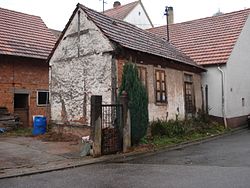Mikveh (Busenberg)
| Mikveh | ||
|---|---|---|
 Mikveh in Busenberg (2007) |
||
| Data | ||
| place | Busenberg | |
| Architectural style | single-storey half-timbered house with gable roof | |
| Construction year | Early 18th century | |
| demolition | 2017 | |
| Coordinates | 49 ° 7 '47.7 " N , 7 ° 49' 47.2" E | |
|
|
||
The mikvah in the Rhineland-Palatinate municipality of Busenberg ( district of Südwestpfalz ) was a house that used to house a ritual immersion bath for Jews . After it became private property, the building was converted into a small residential building and was the only former mikvehaus in the Palatinate until 2017 . As it had become dilapidated for lack of maintenance and was not a listed building , it was demolished in October 2017.
Geographical location
The former Judenbad in Talstraße 8 stood in the center of the village on the slope below today's B 427 , which crosses the village as a through road ( Hinterweidenthal - Bad Bergzabern ). The water needed came from a groundwater source , which probably was even contemporary reportedly close within the building on the same property.
The Jewish school used to stand opposite the mikveh on the south side of Talstrasse.
investment
The single-storey timber-framed building with gabled roof was in a north-south direction traufständig on the road and had an approximately 60 cm high sandstone pedestal. The footprint was about seven by four meters. The entrance door was reached from the street via a three-step sandstone staircase. In its time as a mikveh, the building contained only one room, in the deep center of which there was a brick bath. The ritual ablutions took place there. The depression was later filled in to create a level floor. It is believed that the remains of the tub were still underneath.
The building was uninhabited for years; it looked neglected, the structural condition was very bad. It was poorly renovated in the first half of the 2010s and was inhabited again for a few years.
history
The mikveh was built in Busenberg at the beginning of the 18th century, when the first Jews apparently came to the Wasgau town. In the following decades Busenberg developed into one of the centers of Judaism in the southwest and southern Palatinate . In 1824 a large Jewish cemetery was laid out. In the 1880s, the Jewish community peaked with 31 families and 170 people.
In the years following the construction of the mikveh, due to the increase in population a hundred years after the Thirty Years' War , more manure pits and pigsties were built in the area. The untreated and untreated wastewater entered the groundwater and contaminated it. As a result, the mikveh caused considerable hygienic problems. Therefore, according to an official order of November 17, 1859, the facility should be closed by the health authorities. The completion of the closure could be delayed again and again by objections of the synagogue committee and a neutral expert opinion; Corresponding files from the years 1864/65 have been preserved without any sign of the end of the matter.
The mikveh was still in use in the last third of the 19th century. Towards the end of the century it was finally abandoned and then converted into the small residential building, which was demolished in 2017.
On November 21, 2007 , the Cologne artist Gunter Demnig laid three stumbling blocks for Jews deported during the Nazi era , the Palatinate dialect poet Albert H. , on the edge of Talstrasse, opposite the former mikveh and in front of the property on which the Jewish school used to stand. Keil from Dirmstein presented appropriate texts from his performance “Culture against right-wing violence”.
literature
- Otmar Weber: Judaism in Wasgau . Jewish cultural monuments worth preserving in Wasgau. Verbandsgemeinde Dahner Felsenland , Dahn 2006.
Individual evidence
- ^ A b Otmar Weber: Judaism in Wasgau . Jewish cultural monuments worth preserving in Wasgau. 2006, p. 6 .
- ^ Brigitte Schmalenberg: Rich Jewish heritage . In: The Rhine Palatinate . Ludwigshafen March 1, 2008.
- ↑ ne / tre (author's abbreviation): Last mikveh house demolished . In: The Rheinpfalz , Südwestdeutsche Zeitung . No. 246 . Ludwigshafen October 23, 2017, p. 10 .
- ^ Remnants of Jewish life in Busenberg. Society for Christian-Jewish Cooperation in Rhineland-Palatinate, 2006, accessed on October 23, 2017 .
- ↑ a b c Royal Bavarian Land Commissioner Pirmasens , files in the archive of the city of Pirmasens .
- ↑ Otmar Weber: Invitation to the laying of the Stolperstein on November 21, 2007. (No longer available online.) State working group of memorials and memorial initiatives for the Nazi era in Rhineland-Palatinate, archived from the original on October 23, 2017 ; accessed on October 23, 2017 . Info: The archive link was inserted automatically and has not yet been checked. Please check the original and archive link according to the instructions and then remove this notice.
- ^ Albert H. Keil: Exposé "Culture against Right-Wing Violence". Verlag PfalzMundArt, accessed on October 23, 2017 .

